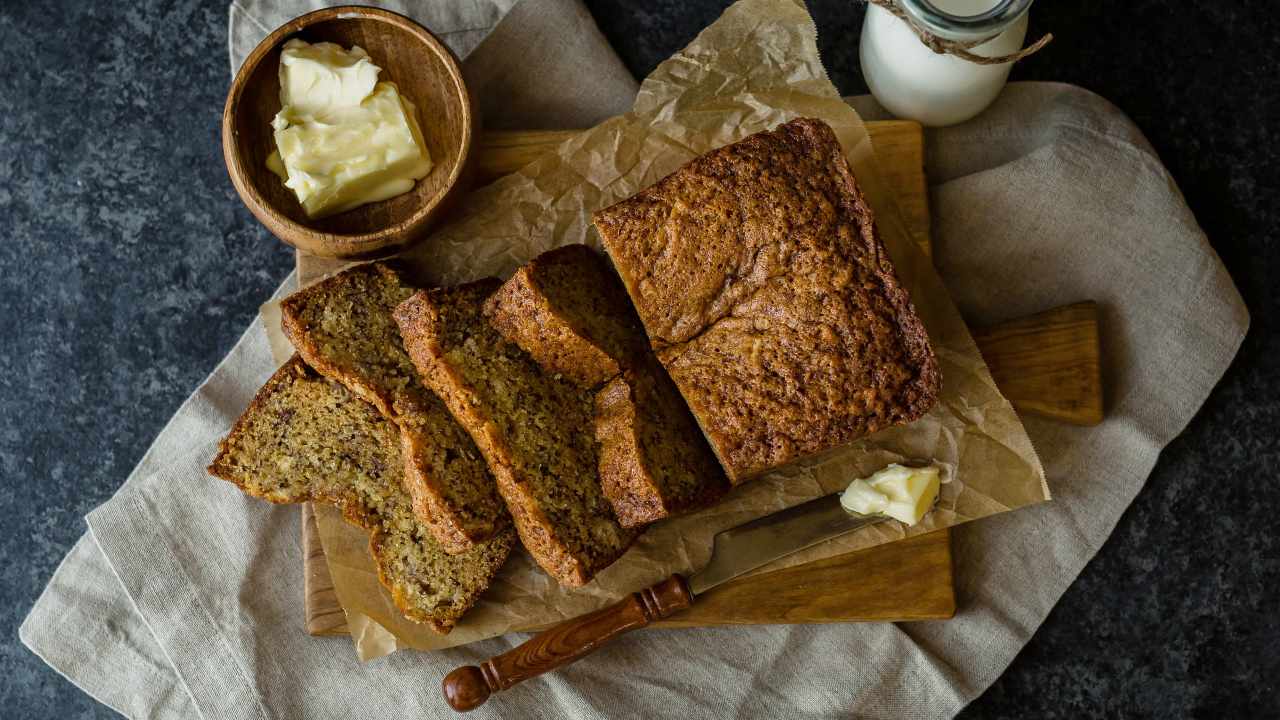Welcome to this bumper meal planner with recipes for 2 days’ of meals, snacks and drinks, created specially for the Seasonal Reset Retreat on EkhartYoga!
The beauty of some of these recipes is that they make several servings, so you can save extra batches to eat throughout the week and bring the retreat feeling with you for a few more days!
If it’s Winter where you are, you may feel more heavy, sluggish and lethargic, so you’ll benefit from light, astringent and gently warming foods. When the weather is cold outside, our bodies need foods and drinks that keep our digestive fire burning bright. We also need a little more vitamin C to support the immune system, and B vitamins to keep our energy levels balanced.
If you are following this retreat in Summer and feeling the heat right now, you’ll benefit from cooling and soothing foods so we’ve added different alternatives for warmer weather too.
How we eat is just as important as what we eat, so try to enjoy making these recipes at a slow pace, and sit in a calm and peaceful space to eat them.
Meal planner
Day 1
- Warm Water with Lemon and Honey
- Breakfast: Breakfast Crumble for One (Winter) or Rose, Cardamom & Coconut Rice Pudding (Summer)
- Mid-Morning Snack: Easy Sweet & Salty Stuffed Dates
- Lunch: Vata-Balancing Sweet Potato Soup
- Teatime Treat: Golden Milk
- Evening Meal: Pumpkin, Cauliflower & Coconut Stew, with Roast Pumpkin Seeds – or Kitchari alternative
Day 2
- Warm Water with Lemon and Honey
- Breakfast: Nourishing Banana Bread
- Mid-Morning Snack: Chocolate Avo Mousse
- Lunch: Golden Soup
- Teatime Treat: Cosy Chai or Summer option – Afternoon Delight Smoothie
- Evening Meal: Mushroom & Kale Dhal
Recipes for day 1
Warm Water with Lemon and Honey
Starting your day with this recipe helps kick-start the digestive system, improves liver health, warms the body and provides an immune-boosting dose of vitamin C. Honey is high in antioxidants and also aids immune health. Try to source local raw honey if possible, for even more benefit.
INGREDIENTS (serves 1)
1 cup warm water
Juice of ½ lemon
1 tsp honey
METHOD
Add all ingredients to a mug
Stir and sip
Breakfast Crumble For One
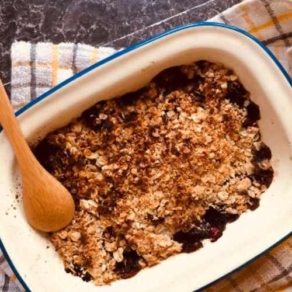
When we eat seasonally, we give ourselves the right nutrients at the right time, which contributes to a healthy gut, strong immune system, improved digestion, and enables us to maintain optimal levels of vitamins and minerals throughout the year.
As the weather gets colder, we also benefit from focusing on foods that warm us from the inside, and help cultivate a strong digestive fire – known as ‘Agni’ in the Ayurvedic texts. Instead of sipping cold smoothies or eating fruit salads, Winter is the season for warm, easy-to-digest foods like overnight oats, stewed fruits, or this simple breakfast crumble recipe.
To make your crumble seasonal, choose local apples and berries, or look for fruits grown in your country in your local farm shop or market.
INGREDIENTS (serves 1)
1 apple, chopped
1 handful berries
1/8 tsp cinnamon
1/8 tsp ginger
1 tbsp water
2 tbsp oats
1 tbsp ground almonds
1 tbsp coconut oil
METHOD
Preheat the oven to 200C
Add the chopped apple, spices and water to a small ovenproof dish
Bake for around 10-15 minutes until the apples are soft
Meanwhile, use your hands to mix and ‘rub’ together the rest of the ingredients to create the crumble topping. Feel free to add extras here like pumpkin seeds, chopped walnuts, or shredded coconut.
Remove the apples from the oven and top with the crumble mixture. Place back in the oven and bake for a further 15-20 minutes, or until the top is gently browned.
Serve warm with dairy or plant-based yoghurt
Rose, Cardamom & Coconut Rice Pudding – Summer option
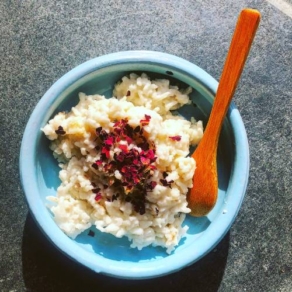
If it’s Summer where you are this recipe is full of cooling, calming and grounding qualities to help you bring down the heat. Basmati rice is easy to digest, whilst cardamom is anti-inflammatory and high in antioxidants. Rose is calming and soothing, and coconut is cooling and great for supporting hormone health. Cooked-and-cooled rice also contains more resistant starch, increasing good gut bacteria and improving digestion.
INGREDIENTS
(Makes enough for several days. Do not reheat the rice, enjoy it cool instead)
1 cup rice
2 cups water
5 crushed cardamom pods
2 tsp vanilla extract
1 can coconut milk
1/2 tsp rose water (optional)
Pinch of salt
Pinch of rose petals (optional)
METHOD
Cook the rice until all the water has evaporated
Add the cardamom, vanilla, salt, rose & coconut milk
Heat & stir gently for 5-10 mins
Take off the heat & leave to cool
Serve a portion topped with optional rose petals. If you’re eating this for breakfast instead of a snack or dessert, add nuts and seeds or stir in some protein powder to increase the protein content.
Easy Sweet & Salty Stuffed Dates
Dates are high in antioxidants and fibre, as well as providing a naturally grounding and calming sweet taste. Almond butter adds a dose of satisfying protein too.
INGREDIENTS (makes 5 stuffed dates)
5 medjool dates
5 tsp almond butter
1 pinch of salt per date
1 pinch of cinnamon per date
METHOD
Carefully slice the dates and remove the stones
Replace the stones with 1 tsp almond butter per date
On top of the almond butter, add a pinch of salt and cinnamon, then squeeze the date closed again
Repeat for all 5 dates
Store in the fridge and consume within a week (if they last that long!)
Vata Balancing Sweet Potato Soup
The Vata dosha is characterised as having cold, rough, dry, light, and irregular qualities. These qualities are also present during Autumn and Winter, which means we may develop a ‘Vata imbalance’. Having a ‘Vata imbalance’ means we’ve accumulated those qualities of dryness (such as dry skin), irregularity (irregular bowel movements or digestion), or lightness (as in feeling very ‘ungrounded), and may begin to feel out-of-balance within ourselves. This soup is a great way to both prevent and remedy excessive Vata energy. Consume this soup often during Autumn and Winter, as well as being sure to practice Vata-balancing everyday actions like self-massage (abhyanga), steady, slow yoga practices, and time for stillness and rest.
INGREDIENTS
1 large red onion
2 medium sweet potatoes, chopped into cubes
4 Carrots, sliced
2 celery sticks, slices
1 Clove of garlic, finely chopped
2 tsp of coconut oil or ghee
Bouillon vegetable stock (3 tsp in 1.5 litres of boiling water) or 1 stock cube
OPTIONAL
½ an inch of fresh ginger (especially good for Winter time, helps reduce excessive Kapha energy, and aids in digestion)
1 tsp turmeric & pinch of black pepper
1 tsp paprika or chilli powder for more heat
METHOD
Heat the coconut oil or ghee in a large pan
Add the onion and garlic, and cook for a couple of minutes
Add any of the dry spices you’re using, and cook for a couple of minutes until fragrant
Add all the chopped vegetables, stir well & cook until the sweet potato begins to soften slightly
Add the stock, salt and pepper
Bring to a simmer, then turn down the heat and partially over the pot
Leave gently simmering for about 25 minutes or until all the vegetables are soft
Turn off the heat, then use a hand blender to blend to your desired consistency
Serve with turmeric biscuits or warm bread, and a sprinkling of chilli flakes if you want to increase the heat
Golden Milk
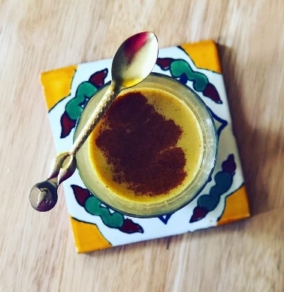
Golden milk is a traditional Ayurvedic recipe, blending spices that enhance digestion, warm the body, and decrease inflammation. Turmeric is renowned for reducing joint pain, and research even shows it helps improve brain and gut health too. This is a satisfying, sweet and delicious way to consume the benefits of spices regularly. Feel free to omit some of the spices if they’re not available to you.
INGREDIENTS (serves 1)
1 cup milk of choice
¼ tsp ground turmeric
¼ tsp cinnamon
¼ tsp ginger
Pinch of ground nutmeg
Pinch of cardamom
Pinch of black pepper
Pinch of good quality salt
1 tsp coconut oil or ghee
1 tsp honey to sweeten
METHOD
Add all spices, milk and coconut oil or ghee to a pan
Bring to a simmer and leave simmering very gently for 5 minutes (do not boil)
Remove from the heat, strain into your favourite mug, stir through the honey and top with a sprinkle of cinnamon.
Pumpkin, Cauliflower & Coconut Stew
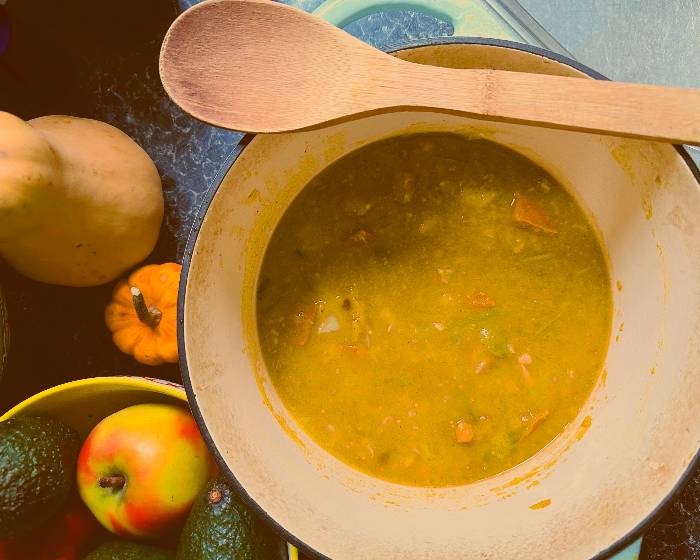
This simple, hearty and warming stew is full of important nutrients that nourish the immune system, eyes, liver, heart and nervous system. Including healthy fats from the coconut milk enables the fat-soluble vitamins A and K to be much more easily absorbed, meaning you’re getting a lot more nutrients from your meal simply by combining these simple ingredients!
This recipe makes a big batch, so use any leftovers for lunch, or blend them up to create a sauce to accompany pasta or curry.
INGREDIENTS (Serves 4 with enough for leftovers)
1 medium pumpkin
¼ head cauliflower
1 leek
2 cloves garlic
1 can chickpeas
Handful of dark leafy greens
1 can full fat coconut milk
1 litre broth or stock
½ tsp paprika
½ tsp cinnamon
½ tsp cumin
¼ tsp chilli powder
1 tbsp coconut oil, butter or ghee
Generous pinch of salt
METHOD
Heat the oil or butter in a large pan on the stovetop
Finely chop the garlic and leek (you could also use onion) and fry for a minute or so
Chop the pumpkin into bite-size pieces, then add to the pan along with the spices and stir well
Break the cauliflower into florets, then add to the pan, stir again, and cook everything for about 10 minutes, stirring often so that nothing sticks to the bottom of the pan (if it does, add a splash of water to deglaze the base of the pan)
Next, add the stock, and cook for about 30-45 minutes with a lid on the pan, on a low heat, until the pumpkin and cauliflower have softened and the liquid has reduced by half
About 10-15 minutes before the end of the cooking time, add in the coconut milk, salt, chickpeas and leafy greens, stir and leave to finish cooking.
When you’re ready to eat, serve with a sprinkle of roasted pumpkin seeds (recipe below)
Simple Roast Pumpkin Seeds
When you’re cooking pumpkin or squash, you’ll realise that a lot of the waste is made up of the seeds! Instead of throwing them away, turn them into a nutritious topping or snack. Pumpkin seeds are high in zinc, which is important for the immune system, as well as improving hormonal balance and fertility.
INGREDIENTS
Any pumpkin or squash seeds you have left over from cooking
Drizzle of olive oil
Pinch of salt
½ tsp cumin
½ tsp chilli flakes
METHOD
Preheat the oven to 180C
Mix all ingredients and spread over a baking tray
Bake for roughly 10-15 minutes or until browned and crispy, mixing half way
Leave to cool, then enjoy as a snack or topping for soups, stews and warm Winter salads.
If pumpkins and squash are not in season you can try this recipe for Kitchari instead. Kitchari is a dish made with rice and pulses which is suitable for all times of year.
Recipes for day 2
Nourishing Cinnamon Banana Bread
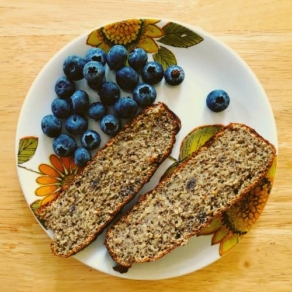
Filling, warming and high in potassium for muscle and heart health, this recipe will last several days. Enjoy for breakfast or as an afternoon treat, served spread with butter, cashew butter or jam.
INGREDIENTS
3 ripe bananas
1 cup almond flour
½ cup oats
2 tbsp spelt or rye flour
2 eggs
½ tsp bicarbonate of soda
½ tsp sea salt
½ cup milk
2 tbsp flax
2 tsp psyllium husk (optional)
1 tsp vanilla extract
½ tsp cinnamon
2 tbsp coconut oil
METHOD
Preheat the oven to 180C
Line or grease a loaf tin
In a large bowl, mix together all dry ingredients to evenly distribute
Add the bananas, eggs, milk and vanilla to a blender and whizz
Pour the wet ingredients into the bowl, add the coconut oil and mix
This is also a good time to add any extra ingredients like nuts or seeds, cacao nibs or berries to the mixture
Pour the batter into the loaf tin
Bake for roughly 30-45 minutes
Check the loaf by inserting a knife or cocktail stick, and if it comes out clean you’ll know your banana bread is ready!
Either eat warm with a generous spread of butter, or leave to cool and cut a slice for breakfast the next day
Chocolate Avo Mousse
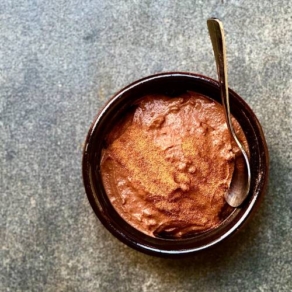
This recipe feels indulgent, yet it’s completely healthy and provides an abundance of nutrients. Cacao is high in theobromine, which is uplifting, helps boost mood and focus, and is anti-inflammatory. Avocado is full of healthy fats, and a great source of vitamins C, E and K. Quick and easy to make, you can bulk the recipe up by adding a scoop of protein powder, and or make several servings to keep on hand throughout the week.
INGREDIENTS (serves 1)
½ large avocado
1 tbsp cacao or cocoa powder
Splash of milk (dairy or plant based)
½ banana
Pinch of salt
¼ tsp vanilla extract
Dash of cinnamon to serve
METHOD
Add everything other than the cinnamon to a blender and whizz until it reaches a mousse consistency
Scoop into a bowl and top with cinnamon. Enjoy!
Optional add-ins:
1 scoop protein powder
1 handful frozen greens
Serving of berries to top
Chopped walnuts to top
Golden Soup
If you enjoyed the Golden Milk recipe yesterday, try this savoury way to get another dose of anti-inflammatory spices and comforting flavours. This golden soup recipe is perfect for a Winter’s evening.
From an Ayurvedic standpoint, this is a great Vata-pacifying soup, meaning anyone who feels cold and achy, with painful joints, who feels a little anxious, vulnerable or who has irregular digestion can highly benefit from this deeply rejuvenating and nourishing soup. If you’re plant-based, swap the ghee for coconut oil, as the healthy fats help your body properly absorb the benefits of turmeric.
INGREDIENTS (serves 4)
1 red onion, finely chopped
½ celeriac
2 carrots, roughly chopped
¼ butternut squash
1 large tsp organic ghee
2 tsp ground turmeric
½ tsp black pepper
¼ tsp good quality salt & more to taste if needed
½ tsp ground cumin
1 thumb-size piece of fresh ginger, grated, or ½ tsp ground
1 good quality stock cube
Toppings (optional)
Coconut flakes
Chilli flakes
METHOD
Chop the celeriac and butternut squash into cubes beforehand
Melt the ghee in a large pan
Add the onion and cumin, and cook until the onion begins to soften
Add the carrots and ginger and stir
After a few minutes, add the celeriac and butternut squash and stir again to coat everything in the spices and ghee
Prepare the stock by stirring 1 litre of hot water and 1 stock cube together, then pour the stock liquid into the pan, and bring to a simmer
Once bubbling, add the salt, turmeric and black pepper, and turn the heat to low, leaving it to simmer for 30-40 minutes
Depending upon how many people you’re feeding, you may prefer to add a little more water at this point
Once the butternut squash and celeriac have softened, remove from the heat and use a hand blender to blend until your soup reaches the desired consistency.
Serve in your favourite bowls, and top with a few coconut flakes and a pinch of chilli flakes for extra warmth.
Cosy Chai
When the day is grey, cold, damp and blustery, we benefit from bringing in the opposite qualities, such as warmth, stillness, cosiness, and even herbs and spices that are slightly drying. These aspects can all help to balance the Ayurvedic Vata and Kapha doshas, which are more likely to become excessive during Winter. Towards the end of Winter especially, the heavy, sluggish and cold nature of Kapha means it’s time to add a generous amount of spice to foods and drinks! Try this classic chai recipe, which is great to sip from your favourite mug, or keep it topped up in a flask throughout the day, so you’re getting a nice big dose of warmth into your body. If you’re not sure what the ‘doshas’ are, you can read more about them and take a dosha test here.
INGREDIENTS (Serves 2)
2 cups water
1 tsp cinnamon
1 tbsp fresh grated ginger
2 cardamom pods
5 cloves
Pinch of black pepper
1 cup milk of choice
2 tsp honey
METHOD
Add all the spices and water to a large pot, and simmer gently for 20 minutes, or until the water has reduced by half.
Turn off the heat and add 2 black teabags to the pot. Cover and steep for 5 minutes (or longer if you want a stronger brew).
Strain into 2 mugs, pour in the milk and stir in honey
Summer alternative – Afternoon Delight Smoothie
I have served this smoothie to yoga retreat guests many times, and am always asked for the recipe! Bananas are high in potassium, which is essential for muscle health and electrolyte balance, and a nutrient many of us don’t get enough of. The almond butter and chia seeds provide healthy fats and protein to keep you full, and the optional maca is a great way to improve cognitive function and boost metabolism. Treat yourself to this afternoon delight.
INGREDIENTS (serves 1)
1 banana
2 dates (stones removed)
1 tbsp almond butter
1 tbsp chia seeds
¼ tsp cinnamon
1 cup organic plant based or non-dairy milk
Optional: 1 tsp ground maca
METHOD
Add all ingredients to a blender, whizz and serve
Mushroom & Kale Dhal
Dhal is a traditional Eastern accompaniment to meals, made with pulses like split peas, beans or lentils. They’re popular in Indian and Nepalese cooking, and are a staple food in these parts of the world. Dhal is high in plant-based protein, and is a complete meal when paired with rice, a warm roti or chapati, or a boiled egg.
The ingredients in dhal mean it’s anti-inflammatory, high in B vitamins and iron (important for maintaining mood and energy levels), folic acid, and zinc. The ingredient list may look long, but it’s really just a few vegetables and pulses, enhanced with tasty spices. It’s worth taking the time to learn how to make dhal, as this is an affordable dish that can go a long way, feeding the whole family with one pot.
Make enough to save leftovers for lunch the next day and the flavours will have further matured, becoming even more satisfying.
INGREDIENTS Serves 4-6
1 large tsp coconut oil or ghee
2 cups mung dhal or split yellow lentils
1 cup chestnut mushrooms
1 leek, sliced into rounds (or 1 onion, diced)
1 clove garlic
3 large tomatoes, cut into quarters
½ inch chopped ginger or 1 tsp ground ginger
2 bay leaves
2 large handfuls of kale leaves (stems removed)
1 bunch fresh coriander
1 can chopped tomatoes
Roughly 4 cups stock (a little more depending on your desired consistency)
spices: 1 tsp mustard seeds, 1 tsp cumin seeds, 1 tsp fennel seeds, 1 tsp turmeric, ½ tsp black pepper, pinch of salt
Shredded coconut and chilli flakes to garnish
METHOD
If your lentils need to soak overnight, make sure you do this beforehand, otherwise, rinse the lentils until the water runs clear, then leave them still damp to one side
Heat the coconut oil or ghee in a large pot
Add the leek / onion and garlic and sauté for a couple of minutes
Add the spices and cook until the mustard seeds begin to pop, and the onion / garlic has softened
Add the lentils, bay leaves and mushrooms and a little salt, cooking for a few moments to soften the lentils
Add the fresh tomatoes and stock, and bring everything to a gentle simmer
Cook until the lentils are softened
When you’re almost done, add the tin of chopped tomatoes, coriander leaves, and the handfuls of kale leaves
Stir in and bring to a simmer again. If you prefer a more soup-y dhal, add a little more water here.
Once the kale has softened, you’re ready to serve.
Scoop into bowls and top with a few sprigs of coriander, shredded coconut and chilli flakes
Serve with chutney, basmati rice, savoury turmeric biscuits and a mint-yoghurt dip.
We hope you enjoy these! You can find lots more recipes on the blog
Main image courtesy of Whitney Wright on Unsplash.

